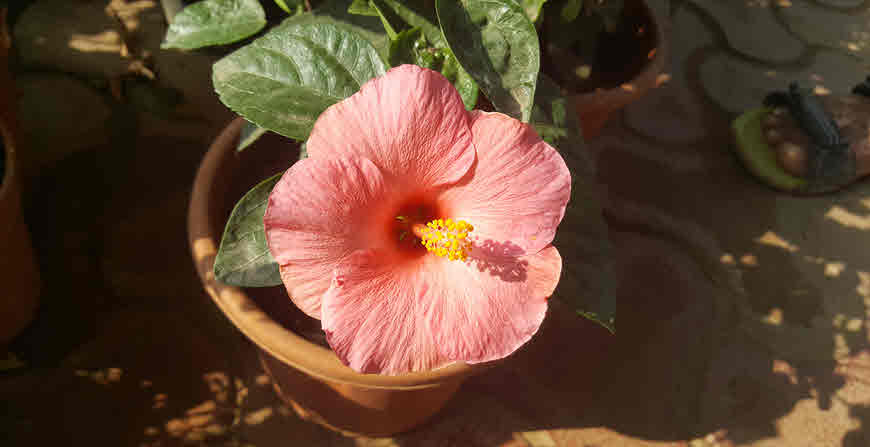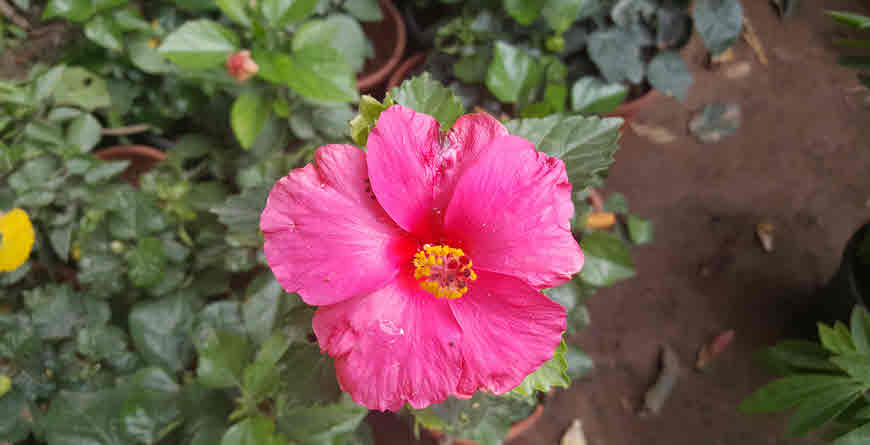Gudhal is also known as Japa, Java (Sanskrit), Semparuthi (Siddha) Gul-e-Gurhal (Unani), Chinese hibiscus, China rose and Shoe flower (English). It is widely grown as ornamental plant in tropical and subtropical regions of East Asia.

Gudhal or Gurhal possess various medicinal activities due to the presence of phytoconstituents such as steroids, flavonoids, tannins, reducing sugar, mucilages, anthocyanin pigment, cyanodin diglucosides, carotene, thiamine, riboflavin, niacin and ascorbic acid. Its leaves and flowers are used in Ayurvedic medicines and various home remedies.

Gurhal is used in folk medicine for the treatment of pain and various inflammatory conditions, gynecological disorders, amenorrhea, asthmatic bronchitis, cough, contraception, etc. The leaves and flowers of the plant are edible and used both internally and externally.
The leaves have anodyne, antidotal, demulcent, expectorant and refrigerant properties. Flowers are used as depurative, febrifuge, pulmonary and stimulant properties. This part is also used in the treatment of burns, pectoral and pulmonary complaints, swellings and other skin problems. A decoction of the flowers is used in the treatment of lung ailments. This plant is recommended for chronic cough, menorrhagia, dysuria and wound caused by burn and scalds. Flowers are a good source of vitamins, flavonoids, ascorbic acid, niacin, riboflavin, thiamine and cyaniding diglucoside.
Scientific Classification of Hibiscus Rosa
All plants are scientifically classified into main 7 levels. These levels are the Kingdom, Division, Class, Order, Family, Genus and Species. A genus comprise of many species and the botanical name consists of Genus (uppercase) followed by Species (lowercase). Genus consists of many species which are closely related and have lots of similarities. Species is the lowest level and represents the group of the same plant.
The botanical name of Gudhal is Hibiscus rosa-sinensis. It belongs to plant family Malvaceae.
Malvaceae includes herbs, shrubs, or less often trees. It consists of about 82 genera, 9 subfamilies and more than 1,500 species, distributed more abundantly in warm and temperate regions. There are about 22 genera and 125 species of this family in India. Plants of the family bears flowers which are often showy and beautiful. They mostly have five petals and sepals and a filament. Members of the Malvaceae family are important as many of them are used as vegetable, spices, ornamental plants and as a fiber crops (particularly cotton, Gossypium). They bear beautiful flowers and grown in the gardens. Some of the economically important plants belonging to Malvaceae are, The cotton plant (Gossypiurn sp.), Corchorus (Jute), Okra (A. esculentus), Bombax (Silk cotton tree), Marshmallow (Althaea ojficinalis Linn.) and Sida.
Below is given taxonomical classification of the plant.
- Kingdom – Plantae
- Subkingdom – Tracheobionta
- Super division – Spermatophyta
- Division – Magnoliophyta
- Class – Magnoliopsida
- Subclass – Dilleniidae
- Order – Malvales
- Family – Malvaceae
- Genus – Hibiscus
- Species – Hibiscus rosa-sinensis
General Information
Plant Description: Hibiscus rosa-sinensis is native to Tropical Asia. It is an evergreen woody, glabrous, showy shrub 5- 8 feet in height.
Leaves: Leaves are simple ovate or ovate- lanceolate. Leaves are entire at the base and coarsely toothed at the apex. Taste is mucilaginous.
Flowers: Flowers are pedicillate, actinomorphic, pentamerous and complete. Corolla consists of 5 petals, red in color and about 3 inches in diameter.
Roots: Cylindrical of 5-15 cm length and 2 cm in diameter, off white in color light brown transverse lenticies. Its fracture is fibrous. Roots taste sweet and mucilaginous.
Varieties: Many varieties exist differing in size and color, in single (or) double forms. The important colors include Red, White, Yellow, and Light Red.
Flowers throughout the year.
- Part(s) used for medicinal purpose: leaves, buds and flowers
- Plant type / Growth Habit: Shrub
- Duration: Perennial
- Distribution: Grown all over India.
- Effect on tridosha: It cures Kapha and Pitta roga.
- Potency: Cool
- Safety Profile: Completely Unsafe to use in pregnancy.
Vernacular names / Synonyms
- Sanskrit: Japa, Japapushpa, Raktapushpi, Japakusuma, Arkapriya, Aruna, Harivallabha, Japapushpa, Java, Joba, Ondrakhya, Pratika, Raktapushpi, Trisandhya
- Hindi: Jasut, Jasun, Gudhal, Gurhal
- English: Chinese hibiscus, Chinese rose, Rose of China, Shoe Flower
- Bengali: Joba, Javaphul, Jaba
- Gujarati: Jasuva, Jasus
- Kannada: Daasavala, Kempu daasavala, Kempu pundrike
- Malayalam: Ayamparathi, Chembarathi
- Telugu: Java pushapamu, Dasana
- Tamil: Separuti, Arattam, Mandaram, Sapattuppu, Sembarattai, Sevarattai
- Oriya: Mondaro
- Assam: Joba
- Punjabi: Jasun
- Siddha: Semparuthi
- Unani: Gul-e-Gurhal
- Arabic: Angira
- Persian: Angira
Constituents of Hibiscus rosa-sinensis
Anthocyanins, flavonoids, cyanidin-3,5-diglucoside, cyanidin-3-sophoroside-5-glucoside, quercetin-3,7-diglucoside, quercetin-3-diglucoside, cyclopeptide alkaloid, cyanidin chloride, quercetin, hentriacontane and riboflavin, ascorbic acid and thiamine. Iron, phosphorus, calcium, riboflavin, thiamine, niacin is also present.
Important Medicinal Properties of Hibiscus rosa-sinensis
Hibiscus rosa-sinensis is rich in medicinal properties. The understanding of these properties will help us to better utilize this herb. These also indicate the conditions in which we should avoid it. For example it is not recommended to use internally Hibiscus rosa-sinensis while trying to have baby due to its antifertility, anti-spermatogenic and contraceptive properties. It must not be used in pregnancy as it abortifacient in action.
Below is given medicinal properties along with the meaning.
- Abortifacient: Causing abortion.
- Antifertility: Tending to reduce or destroy fertility
- Antiestrogenic: Blocks the production or utilization of estrogens, or inhibits their effects. Estrogens are the family of hormones that promote the development and maintenance of female sex characteristics.
- Anti-implantation: Prevent implantation or attachment of the fertilized egg to the uterine lining.
- Anti-ovulatory: Suppressing ovulation.
- Anti–inflammatory: Reducing inflammation by acting on body mechanisms.
- Anticonvulsant: Prevent or reduce the severity of epileptic fits or other convulsions.
- Antioxidant: Neutralize the oxidant effect of free radicals and other substances.
- Antispasmodic: Used to relieve spasm of involuntary muscle.
- Anthelmintic: Antiparasitic, expel parasitic worms (helminths) and other internal parasites from the body.
- Anti–hyperglycemic: Counteracting high levels of glucose in the blood.
- Contraceptive: Serving to prevent pregnancy.
- CNS depressing: Depression of the central nervous system that can result in decreased rate of breathing, decreased heart rate, and loss of consciousness.
- Diuretic: Promoting excretion of urine/agent that increases the amount of urine excreted.
- Depurative: Purifying agent.
- Emmenagogue: Stimulates or increases menstrual flow.
- Hypotensive: Lowers blood pressure
Important Indications of Shoe flower
- Asthma, cough
- Boils, wounds, ringworm
- Contraceptive
- Gynecological conditions
- Hair loss and dandruff problems
- Produce abortion
- Regulation of menstrual cycle
- Sexual diseases
Medicinal uses of Gudhal – Hibiscus rosa-sinensis
Flowers decoction is very useful in bronchial catarrh. Infusion of flowers petal acts as refrigerant drink in the fever and acts as demulcent in cough and useful in strangury, cystitis and other genito-urinary problem.
The flowers and leaves are great remedies for hair problem like hair loss and hair greying. The flowers fried in butter is very effective for excessive menstruation. The leaves of the plant are used in fatigue and skin disease. Flowers can be taken in a dose of 10-20 grams.
Internal use of Gudhal is contraindicated in small children and pregnant or lactating women.
Abortion
Eating 10 flower buds daily cause abortion.
Alopecia, Hair fall and dandruff
- For hair fall and dandruff, Take 10-15 leaves or flowers of gudhal and 100 gm of coconut oil and cook at very low flame as coconut oil may catch fire at high flame, cook till the leaves are completely cooked then drain it and keep thus formed oil in bottle and use it. Or
- Flower bud paste is applied regularly one hour before going to bath is useful. Or
- Flower paste is applied on the head. Or
- Take juice of fresh flowers + olive oil, in equal amount and cook on fire till only oil is left. Apply this oil on scalp.
1- Anemia
Drink decoction of its leaves with water.
2- Boils and swellings
The leaves and young flower buds are used as a poultice.
3- Causing sterility/infertility in women, to prevent conceiving
Eating 10 flower buds daily causes permanent sterility.
4- Cough
Take 5-10 gm of root and boil in 400 gm of water till water reduces to ¼ drain and drink.
5- Fevers, coughs and venereal diseases
A decoction of the roots is given.
6- Intestinal worms
Leaf chutney is given.
7- Indigestion and acidity
Take 3-4 leaves with water it removes toxins from the body.
8- Leucorrhea
- For leucorrhea, Take 3 flowers empty stomach with a glass of water in morning. Or
- 5 gm leaf powder is given, twice a day.
9- Menstrual bleeding
In excess menstrual bleeding drinking Hibiscus tea with cinnamon is very effective. It also provides supplemental iron in menorrhagia, as low serum iron causes the blood vessels in the uterus to lose their capacity to constrict which increase menstrual bleeding. Or
3-5 Red flowers ground in water are given.
10- Mouth ulcers
Chew 3-4 leaves of Gudhal.
11- To start periods
Flower ground with sesame oil is given.
12- Vitiligo
Eat 5 flowers twice a day for two years or more.
13- Warts, carbuncles, ringworm
- Leaf paste with rice is applied. Or
- Leaf paste with lime juice is applied.
14- Weakness
Eat gulkand of gudhal flower. For making gulkand take flowers and put them with an equal amount of Mishri (candy sugar) in jar and keep it daily in sun. After few days gulkand would be ready to eat and take it 1-2 spoon daily.
Contraindications, Interactions, Side-effects, and Warnings
- Do not use in pregnancy.
- It can cause abortion.
- Do not use while trying to have baby.
- It reduces fertility in both males and females.
- In males, it reduces sperm production.
- In females, it reduces ovulation, prevents implantation and causes miscarriage.